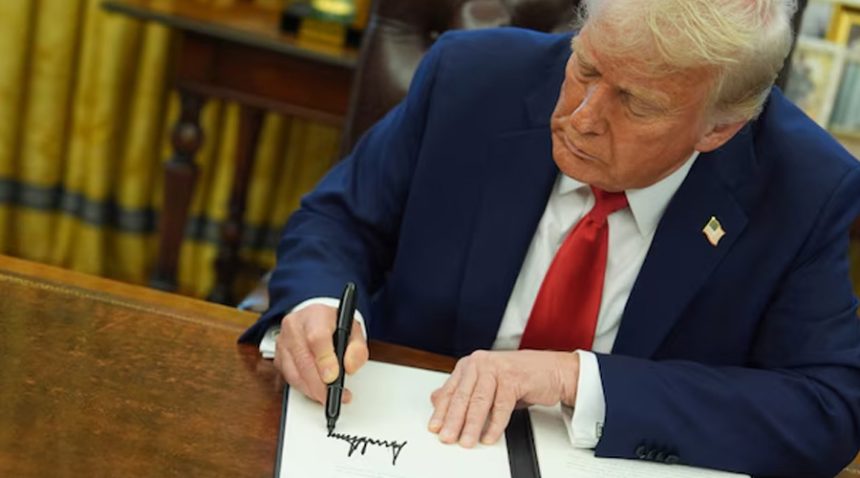An SBI report suggests that the new tariffs may decrease India’s exports to the US only by 3-3.5%
The probable impact of the recently suggested reciprocal tariffs by US President Donald Trump on India’s economy remains debatable. The new US Trade Tariffs may result in the changing of the current trade patterns. Although their overall impact on India is likely to be zero, per different reports and experts.
The tariffs, meant to balance trade relations between the US and its trading partners, will affect various industries, some more vulnerable than others. Let’s explore the economic effects of Trump’s trade tariffs and their potential implications for India.
India’s Export Diversification Strategy
India has made a conscious effort to shift away from raw materials export, towards high-value finished products. This strategic realignment has helped neutralize the possible negative impact of the tariff increases.
A State Bank of India report suggests that the imposition of retaliatory tariffs, even at the rates of 15-20%, would decrease only India’s exports to the US by around 3-3.5%. Such a marginal decrease would not be hurtful to India’s overall economic interests. Especially, since India is already diversifying its export base.
The US has been one of India’s top export markets for a long time, contributing to India’s trade surplus. In the 2023-24 fiscal year, American exports accounted for some 17.7% of total Indian exports. Even though the Trump administration’s tariff demands can disturb trade flows. India’s concerted attempts to reach other destinations like Europe and the Middle East will reduce some of the damage.
Sector-Specific Vulnerabilities
The overall optimistic mood is anticipated, certain sectors. However, sectors that are export-dependent on labor-intensive products like textiles, garments, and footwear, could be affected. These sectors have historically contributed a significant share of India’s exports to the US. However, the proposed tariff increases could make Indian products less competitive in the US market, making them more expensive and lowering demand.
Textiles, for instance, are among the most exposed sectors under a tariff system geared toward high-value merchandise. Indian textile industry is globally competed against aggressively by China and Bangladesh. The nation’s manufacturers can expect mounting costs if the tariffs are high. Thus, rendering the Indian manufacturers uncompetitive in export markets.
Opportunities Amidst Uncertainty
On the other hand, the US tariff hike against China and other countries might provide an opportunity for India to expand its market share, with companies looking for alternatives to Chinese products. India can capitalize on such shifts, particularly in the electronics and manufacturing of machinery sectors, where the country is boosting production capacity. With companies seeking to diversify sources of their supply chain other than China, India can position itself as a strategic supplier for the US market.
Further, to raise the overall competitiveness of the nation on a world stage, India has also re-evaluated its trade streams. Recently, there have been efforts aimed at bringing down the cost of logistics as well as streamlining supply chains. By doing that, India anticipates it will be in a position to deal better with world trade headaches without necessarily relying too heavily on the sole market.
Economic Adjustment Measures
To address the impending tariffs, India is considering different alternatives, like retaliatory tariffs on American exports. The retaliatory tariffs could be put on American exports to India, like agricultural products, motorcycles, and advanced electronics. However, retaliatory tariffs are more likely to lead to a full-scale trade war that hurts the two economies as well as creates more uncertainty.
To strike a balance in the trade equation, India can also consider increasing imports from the US. This can be done in areas like biotechnology, medical devices, and energy. It will also reduce the trade deficit and alleviate the effect of the tariff hikes.
India’s focus on developing its indigenous manufacturing base, particularly through initiatives such as the Production-Linked Incentive (PLI) scheme, is bound to help reduce reliance on imports. This will also drive expansion in strategic segments such as electronics and pharmaceuticals.
Apart from these measures, India is also trying additional reductions on tariffs on some products, including luxury vehicles, solar panels, and chemicals, to create goodwill in two-way trade relations. These measures can ease the burden of anticipated tariff hikes and prevent any significant disruption to trade between the two countries.
Conclusion
The likely Trump trade tariff impact on India’s economy may not turn out to be as dismal as estimated initially. This is due to the nation’s foresight in the diversification of its exports, streamlining supply chain efficiencies, and strengthening trade ties with other countries.
Some sectors may be hit, like the textile sector. However, India’s indigenous manufacturing push is expected to serve as a buffer. The overall effect will depend on how the tariff policies evolve. It will also depend on the degree of coordination between the two countries in managing the trade imbalances. Through skillful negotiation and compromise, India can navigate through the hurdles posed by these changes and further extend its international trade footprint.






